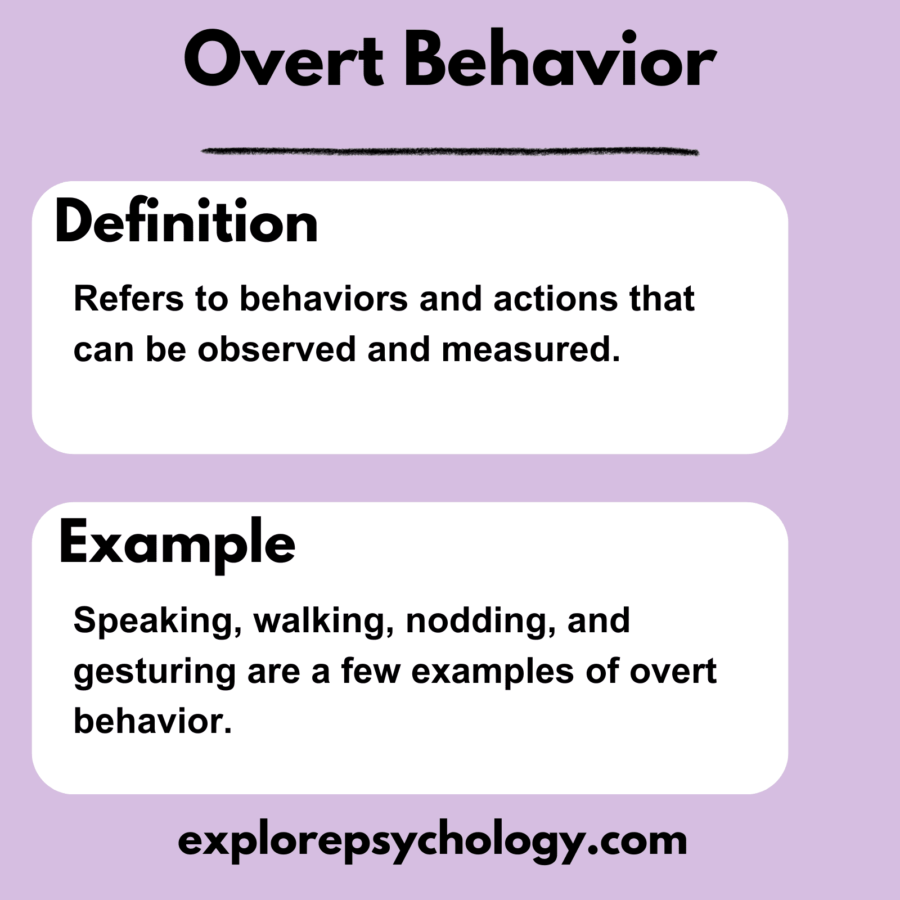Overt Behavior: Definition and Examples in Psychology
Overt behavior refers to actions that can be observed and measured. In other words, these are the behaviors that other people can see, such as your speech and physical actions. Overt behaviors can be contrasted with covert behaviors. Covert behaviors are actions and mental processes that occur in the mind and cannot be readily observed….

Overt behavior refers to actions that can be observed and measured. In other words, these are the behaviors that other people can see, such as your speech and physical actions.
Overt behaviors can be contrasted with covert behaviors. Covert behaviors are actions and mental processes that occur in the mind and cannot be readily observed. Unlike covert behaviors, overt behaviors are visible, observable, and measurable.

Meaning of Overt Behavior
In psychology, these observable behaviors are a cornerstone for empirical investigation and theoretical development. Such behavior refers to observable actions or responses that can be directly measured by external observers. Unlike covert behavior, which encompasses internal processes like thoughts and feelings, overt behavior manifests in the physical realm, making it accessible to anyone paying attention.
Overt actions are important in behavioral psychology, an area of psychology that focuses on observable actions and their environmental influences. Overt behaviors are measurable outcomes that form the empirical basis for rigorous scientific inquiry, allowing behaviorists to study human behavior objectively. These behaviors are viewed as products of interactions between individuals and their environment, with environmental stimuli shaping behavioral responses through conditioning and learning processes.
Overt actions are also the primary target for behavior modification techniques. Such techniques are used for practical applications in education, parenting, organizational management, and clinical psychology. By systematically observing and manipulating overt behaviors, behaviorists promote an understanding of behavior change mechanisms and effective interventions for enhancing individual and societal well-being.
Examples of Overt Behavior
Examples of overt behavior abound in our daily lives and encompass a wide range of observable actions and responses. Here are some common examples:

- Smiling: A genuine smile is a classic example of overt action that communicates happiness, friendliness, or amusement. It involves the movement of facial muscles, particularly around the mouth and eyes, and is easily recognizable by others.
- Speaking aloud: Engaging in conversation, delivering a speech, or simply uttering words aloud are overt behaviors that involve vocalization. These actions allow individuals to communicate ideas, express emotions, and convey information to others.
- Writing: Whether jotting down notes, composing an essay, or signing a document, writing is an overt action that involves the manipulation of writing instruments to produce visible symbols or marks on a surface, such as paper or a digital screen.
- Gesturing: Hand movements, facial expressions, and body postures constitute overt action known as gestures. These non-verbal cues complement verbal communication and convey meaning, emphasis, or emphasis.
- Eating: The act of consuming food and drink involves overt behaviors such as chewing, swallowing, and using utensils or hands to convey food to the mouth. Eating behaviors are influenced by cultural norms, personal preferences, and physiological hunger cues.
- Walking: Moving from one place to another by alternating steps with the feet is a fundamental overt behavior known as walking. Walking patterns, speed, and posture can convey information about a person’s mood, health, or intention.
- Applauding: Clapping hands together to express approval, appreciation, or admiration is a socially recognized overt behavior often observed in settings such as performances, presentations, and ceremonies.
- Nodding: Inclining the head up and down in a repeated motion is an overt behavior known as nodding. Nodding is commonly used to indicate agreement, understanding, or acknowledgment during conversations.
- Hugging: Embracing another person by wrapping one’s arms around them is an overt behavior known as hugging. Hugging is often used to express affection, comfort, or support in interpersonal relationships.
- Pointing: Extending a finger or hand toward an object or direction is an overt behavior known as pointing. Pointing gestures are used to draw attention, indicate interest, or provide guidance in various contexts.
Covert vs. Overt Behavior
Understanding the distinctions between covert and overt behavior is essential for comprehending the complexities of human interaction and psychological processes. While both types of behavior play significant roles in shaping individual experiences and social dynamics, they differ in their visibility, accessibility, and underlying mechanisms.
Observable vs. Non-Observable Behavior
Covert behavior refers to internal processes that occur within the individual and are not readily observable by external observers. These behaviors encompass thoughts, feelings, beliefs, desires, and mental imagery that occur in the privacy of one’s mind. Covert behaviors are subjective experiences that can vary widely among individuals and are often inferred through indirect indicators, such as verbal reports, introspection, or physiological measures.
In contrast, overt behavior refers to observable actions or responses that are directly measurable by others. These behaviors manifest in the physical realm and can be witnessed without the need for interpretation or inference. Overt behaviors include visible actions, gestures, facial expressions, vocalizations, and bodily movements that occur in social contexts and are accessible to external scrutiny.
Private vs. Public Behavior
One key distinction between covert and overt behavior lies in their level of accessibility. Covert behaviors are inherently private and subjective, accessible only to the individual experiencing them. In contrast, overt behaviors are public and accessible to anyone observing the individual’s actions. This difference in accessibility influences how each type of behavior is studied, assessed, and interpreted in psychological research and clinical practice.
Level of Control
Another distinction pertains to the degree of control individuals have over their behaviors. Covert behaviors, such as thoughts and emotions, may be less consciously controlled and more automatic or spontaneous in nature. In contrast, overt behaviors are often under more conscious control and may be influenced by social norms, situational factors, and individual intentions.
It is important to recognize that covert and overt behaviors can interact and influence each other in complex ways. For example, internal thoughts and emotions may influence overt behaviors, such as facial expressions or speech patterns, while external stimuli and social cues may trigger or shape covert mental processes.
Why Understanding Overt Behavior Is Important
Understanding overt behavior holds significant importance across various domains, including psychology, sociology, education, and everyday social interactions. Here are several compelling reasons why comprehending overt behavior is crucial:
Effective Communication
Overt behavior serves as a primary means of communication in social interactions. Understanding the overt behaviors of others, such as facial expressions, gestures, and vocal tone, enables individuals to interpret intentions, emotions, and social cues accurately. This comprehension fosters effective communication, facilitates mutual understanding, and strengthens interpersonal relationships.
Social Integration
Knowledge of overt behavior is essential for navigating social norms, expectations, and cultural practices. By observing and understanding the overt behaviors of peers, colleagues, and community members, individuals can adapt their own behavior to fit social contexts, thereby promoting social integration and cohesion.
Conflict Resolution
In interpersonal conflicts or misunderstandings, awareness of overt behavior can help de-escalate tensions and resolve disputes. By identifying and addressing problematic behaviors directly, individuals can clarify intentions, express concerns, and negotiate mutually agreeable solutions, thus promoting conflict resolution and reconciliation.
Behavioral Modification
Overt behavior serves as a target for behavior modification techniques in various contexts, including education, therapy, and personal development. By understanding the factors that influence overt behaviors, such as reinforcement, punishment, and environmental cues, individuals can implement strategies to modify behaviors effectively, achieve goals, and promote positive change.
Psychological Assessment
Overt behavior plays a crucial role in psychological assessment and diagnosis. Clinicians and researchers use observable behaviors as indicators of underlying psychological processes, such as mood disorders, personality traits, and cognitive functioning. By carefully observing and analyzing overt behaviors, professionals can make accurate assessments, formulate treatment plans, and monitor progress over time.
Social Influence and Persuasion
Knowledge of overt behavior is essential for understanding the mechanisms of social influence and persuasion. Individuals who are adept at recognizing and utilizing persuasive techniques, such as persuasive language, non-verbal cues, and social proof, can effectively influence the attitudes, beliefs, and behaviors of others in various contexts, including marketing, politics, and advocacy.
Research and Theory Development
In psychology and other social sciences, overt behavior serves as a foundation for empirical research and theoretical development. By systematically studying observable behaviors in controlled settings, researchers can test hypotheses, validate theories, and advance our understanding of human behavior, cognition, and social interactions.
How Overt Behavior Is Used in Psychology
In psychology, overt behavior serves as a cornerstone for empirical investigation, clinical assessment, and therapeutic intervention. This section explores the multifaceted ways in which overt behavior is utilized in psychological research and practice:
Behavioral Observation and Measurement
Overt behavior provides psychologists with tangible and measurable data that can be systematically observed, recorded, and analyzed. Researchers utilize behavioral observation techniques to study a wide range of phenomena, including social interactions, cognitive processes, emotional expressions, and psychopathological symptoms. By objectively documenting overt behaviors in naturalistic or controlled settings, psychologists gain insights into human behavior and its underlying determinants.
Psychological Assessment
Overt behavior plays a crucial role in psychological assessment and diagnosis. Clinicians use behavioral assessments to evaluate an individual’s functioning, identify psychological disorders, and formulate treatment plans. Behavioral assessments may involve structured interviews, behavioral checklists, standardized tests, and direct observation of overt behaviors.
By systematically assessing observable behaviors, psychologists can make accurate diagnoses, tailor interventions to individual needs, and monitor treatment progress over time.
Behavior Modification and Therapy
Overt behavior serves as a primary target for behavior modification techniques in therapeutic settings. Behavioral therapies, such as cognitive-behavioral therapy (CBT), utilize principles of learning theory to modify maladaptive behaviors and promote adaptive coping strategies. Therapists work collaboratively with clients to identify target behaviors, set specific goals, and implement evidence-based interventions to promote behavior change. Focusing on observable behaviors and the environmental factors that influence them allows therapists help clients develop new skills, overcome challenges, and improve their overall well-being.
Experimental Research
Overt behavior is central to experimental research in psychology, where researchers manipulate independent variables to observe their effects on observable outcomes. Experimental designs allow psychologists to investigate causal relationships between variables, test theoretical hypotheses, and establish empirical evidence to support psychological theories.
Researchers can draw conclusions about the underlying mechanisms of human behavior, cognition, and emotion by systematically manipulating and measuring overt behaviors in controlled laboratory settings.
Applied Settings
Overt behavior is also utilized in various applied settings, such as education, organizational psychology, and forensic psychology.
- Educators use behavioral observations to assess student performance, monitor classroom behavior, and implement interventions to support academic success.
- Industrial-organizational psychologists use overt behavior to assess job performance, evaluate leadership effectiveness, and design interventions to improve workplace productivity and morale.
- Forensic psychologists utilize behavioral assessments to evaluate criminal behavior, assess risk factors for violence, and inform legal decisions in forensic settings.
Overt behavior serves as a valuable tool for psychologists across diverse domains, including research, assessment, therapy, and applied settings. By systematically observing, measuring, and analyzing overt behaviors, psychologists gain insights into human behavior, advance scientific knowledge, and promote positive outcomes in individuals and communities.
Sources:
Rachlin H. (2012). Our overt behavior makes us human. The Behavior Analyst, 35(1), 49–57. https://doi.org/10.1007/BF03392265
Smyre, S. A., Wang, Z., Stein, B. E., & Rowland, B. A. (2021). Multisensory enhancement of overt behavior requires multisensory experience. The European Journal of Neuroscience, 54(2), 4514–4527. https://doi.org/10.1111/ejn.15315





